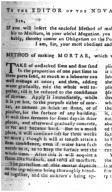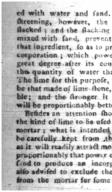[ Method of Making Mortar, which will be Impenetrable to Moisture ] E.F.
Date: 1791/11/05
Source:
Nova Scotia Magazine
Institution: Nova Scotia Archives
| Source Origin: Nova Scotia Newspapers on Microfilm
| Reference: Microfilm Reels 8062, 8063
Instructions for making mortar, which includes an option for making it with milk. nn.667_68. Microfilm Reel 8063.
TO THE EDITOR OF THE NOVA SCOTIA MAGAZINE.
SIR,
IF you will insert the enclosed Method of making Mortar, which will be impenetra-
ble to Moisture, in your useful Magazine, you will oblige a Subscriber, and, very pro-
bably, thereby confer an Obligation on the Public.
I am, Sir, your most obedient and humble Servant, E. F.
METHOD of making MORTAR, which will be impenetrable to MOISTURE.
TAKE of unslacked lime and fine sand
in the proportion of one part lime to
three parts sand, as much as a labourer can
well manage at once; and then, adding
water gradually, mix the whole well to-
gether, till it be reduced to the consistence
of mortar. Apply it immediately, while
it is yet hot, to the purpose either of mor-
tar, as cement to brick or stone, or of
plaister, for the furnace of any building.
It will then ferment for some days in drier
places, and afterward gradually concrete,
or set and become hard. But in a moist
place, it will continue soft for three weeks
or more; though it will at length attain a
firm consistence, even if water have such
access to it, as to keep the surface wet the
whole time. After this it will acquire a
stone like Hardness, and resist all moisture.
The perfection of this mortar depends
on the ingredients being thoroughly blend-
ed together, and the mixture’s being ap-
plied immediately after to the place where
it is wanted. In order to this, about five
labourers should be employed for mixing
the mortar, to attend one person who ap-
plies it. This method of making mortar,
Mr. Dossie says, was discovered by a gen-
tleman of Neuschattel, the back part of
whose house being cut out of a rocky hill,
the spring from the rock greatly annoyed
it, and produced a continual damp, which
nothing could cure till he tried the mortar
above described, which effectually answer-
ed his purpose, and which by time grows
so tenacious and firm, that he was induced
to believe the method of composition was
the same with that pursued by the anti-
ents.
We are told that chalk lime, which is
the kind most commonly used in London,
is unfit for the purpose, on account of the
stints it contains, which render it necessa-
ry to be skreened before it can be temper-
[page break]
ed with water and sand. Previous to
skreening, however, the lime must be
slacked: and the slacking it before it be
mixed with sand, prevents its acting on
that ingredient, so as to produce their in-
corporation; which power it loses in a
great degree after its combination with
the quantity of water that saturates it.
The lime for this purpose, therefore, must
be that made of lime-stone, shells, or mar-
ble; and the stronger it is, the mortar
will be proportionably better.
Besides an attention should be paid to
the kind of lime to be used in making this
mortar; what is intended for it, should
be carefully kept from the access of air,
as it will readily attract moisture, and lose
proportionably that power of acting on the
sand to produce an incorporation. It is
also advised to exclude the sun and wind
from the mortar for some days after it is
applied, that its drying too quickly may
not prevent the due continuance of the
fermentation, which is necessary to favour
the action of the lime on the sand.
This mortar is attended with very par-
ticular advantages; for it may be used,
and will even attain a perfect induration,
though moisture have access to it when it
is applied; and while it is fermenting and
setting, it is extremely beneficial for pre-
venting the oozing of water through the
floors of walls of houses, where the common
method used would have no effect. When
a very great hardness and firmness are re-
quired in this mortar, the using of skim-
med milk, instead of water, either wholly
or in part, will produce the desired effect;
and in this circumstance, likewise, the
preparation is imagined to resemble that of
the antients.
Download: Transcription | Images

